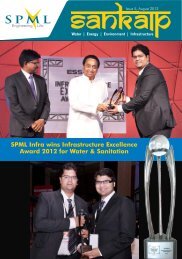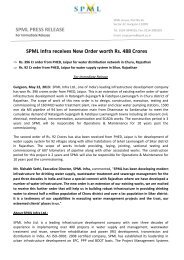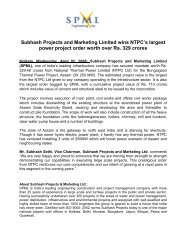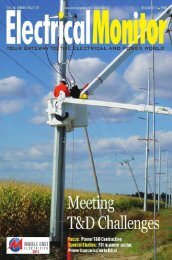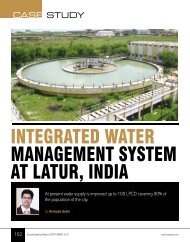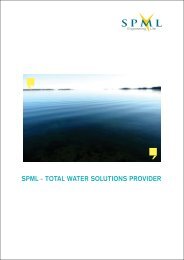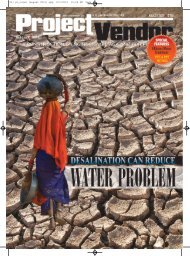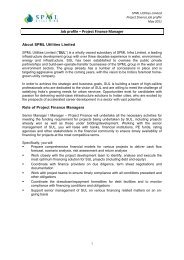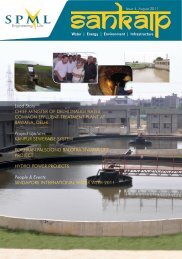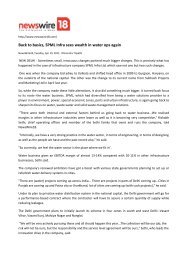You also want an ePaper? Increase the reach of your titles
YUMPU automatically turns print PDFs into web optimized ePapers that Google loves.
ANNUAL REPORT <strong>2009</strong>-<strong>10</strong><strong>SPML</strong> INFRA LIMITED & ITS SUBSIDIARIES (formerly Subhash Projects and Marketing Limited)SCHEDULES FORMING PART OF THE CONSOLIDATED BALANCE SHEET AND PROFIT & LOSS ACCOUNTForeign OperationsFinancial statements of overseas non-integral operations are translated as under:(i) Assets and Liabilities at the rate prevailing at the end of the year.(ii) Revenues and expenses at yearly average exchange rates prevailing during the year.Exchange differences arising on translation of non-integral foreign operations are accumulated in the Foreign Currency Translation Reserveuntil the disposal of such operations.13. Retirement and other employee benefitsRetirement benefits in the form of Provident Fund being a defined contribution scheme are charged to Profit and Loss Account of the year whenthe contributions to the funds are due. There are no obligations other than the contribution payable to the fund.Gratuity being a defined benefit obligation is provided for based on actuarial valuation made at the end of each financial year using the projectedunit credit method.Short term compensated absences are provided for based on accrual basis. Long term compensated absences are provided for based on actuarialvaluation made at the end of each financial year, which is done as per the projected unit credit method.Actuarial gain and losses are recognized immediately in the statement of Profit & Loss Account as income or expenses.14. Income TaxesTax expense comprises of current and deferred income tax . Current income tax is measured at the amount expected to be paid to the taxauthorities in accordance with the Indian Income Tax Act. Deferred taxes reflect the impact of current year timing differences between taxableincome and accounting income for the year and reversal of timing differences of earlier years.Deferred tax is measured based on the tax rates and the tax laws enacted or substantively enacted at the balance sheet date. Deferred taxassets are recognised only to the extent that there is reasonable certainty that sufficient future taxable income will be available against which suchdeferred tax assets can be realised. In situations where the Company have unabsorbed depreciation or carry forward tax losses, all deferred taxassets are recognised only if there is virtual certainty supported by convincing evidence that they can be realised against future taxable profits.Deferred tax in respect of timing differences which reverse during the tax holiday period are not recognised to the extent the Company’s grosstotal income is subject to the deduction during the tax holiday period as per the requirement of the Act.MAT credit is recognised as an asset only when and to the extent there is convincing evidence that the company will pay normal income tax duringthe specified period. In the year in which the Minimum Alternative tax (MAT) credit becomes eligible to be recognized as an asset in accordancewith the recommendations contained in guidance Note issued by the Institute of Chartered Accountants of India, the said asset is created by wayof a credit to the profit and loss account and shown as MAT Credit Entitlement. The Company review the same at each balance sheet date andwrites down the carrying amount of MAT Credit Entitlement to the extent there is no longer convincing evidence to the effect that the Companywill pay normal Income Tax during the specified period.15. Segment <strong>Report</strong>ingIdentification of SegmentsThe Company has identified that its business segments are the primary segments. The Company’s businesses are organized and managedseparately according to the nature of activity, with each segment representing a strategic business unit that offers different products and servesdifferent markets. The analysis of geographical segments is based on the areas in which major operating divisions of the Company operate.The Company at present, primarily operates in India and therefore the analysis of geographical segments is not applicable to the Company.Allocation of common costsCommon allocable costs are allocated to each segment on case to case basis applying the ratio, appropriate to each relevant case. Revenue andexpenses, which relate to the enterprise as a whole and are not allocable to segment on a reasonable basis, have been included under the head“Unallocated - Common”.89



